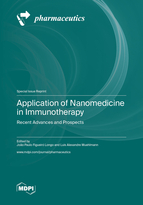Application of Nanomedicine in Immunotherapy: Recent Advances and Prospects
A special issue of Pharmaceutics (ISSN 1999-4923). This special issue belongs to the section "Nanomedicine and Nanotechnology".
Deadline for manuscript submissions: closed (30 October 2022) | Viewed by 32873
Special Issue Editors
Interests: nanomedicine; lipid nanocarriers; oral administration; metastasis prevention
Special Issues, Collections and Topics in MDPI journals
Interests: nanomedicine; nanoemulsion; photodynamic therapy; targeted delivery
Special Issues, Collections and Topics in MDPI journals
Special Issue Information
Dear Colleagues,
Nanomedicine is a special area of medicine focused on the application of nanoparticles and drug nanocarriers to treat a wide variety of diseases, including cancer, infections, and auto-immune disorders. In the last decade, several original articles presented interesting results connecting these nanotechnologies with the activation of the immune system against different diseases. Probably the most prominent example of this was the RNA vaccines against COVID-19 when lipid nanoparticles were used to protect and deliver the nucleotides to the target cells. Of course, this is not the single application referred to as nanomedicine, and several others examples aiming at cancer therapy are also available in the literature. In this application, nanoparticles can be used to modulate the immune response, improving the oncological therapies. Thus, the aim of this Special Issue is to invite authors interested in the most recent science and technology applications of nanotechnology in immunotherapies against different diseases, including cancer, infections, and auto-immune conditions. We welcome submissions of original research, as well as review articles related to nanomedicine and immunological activation.
Dr. João Paulo Figueiró Longo
Dr. Luis Alexandre Muehlmann
Guest Editors
Manuscript Submission Information
Manuscripts should be submitted online at www.mdpi.com by registering and logging in to this website. Once you are registered, click here to go to the submission form. Manuscripts can be submitted until the deadline. All submissions that pass pre-check are peer-reviewed. Accepted papers will be published continuously in the journal (as soon as accepted) and will be listed together on the special issue website. Research articles, review articles as well as short communications are invited. For planned papers, a title and short abstract (about 100 words) can be sent to the Editorial Office for announcement on this website.
Submitted manuscripts should not have been published previously, nor be under consideration for publication elsewhere (except conference proceedings papers). All manuscripts are thoroughly refereed through a single-blind peer-review process. A guide for authors and other relevant information for submission of manuscripts is available on the Instructions for Authors page. Pharmaceutics is an international peer-reviewed open access monthly journal published by MDPI.
Please visit the Instructions for Authors page before submitting a manuscript. The Article Processing Charge (APC) for publication in this open access journal is 2900 CHF (Swiss Francs). Submitted papers should be well formatted and use good English. Authors may use MDPI's English editing service prior to publication or during author revisions.
Keywords
- nanomedicine
- immunotherapy
- immune system
- immune triggering
- immune memory
- innovation








